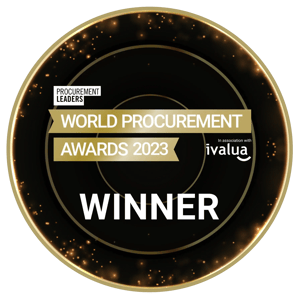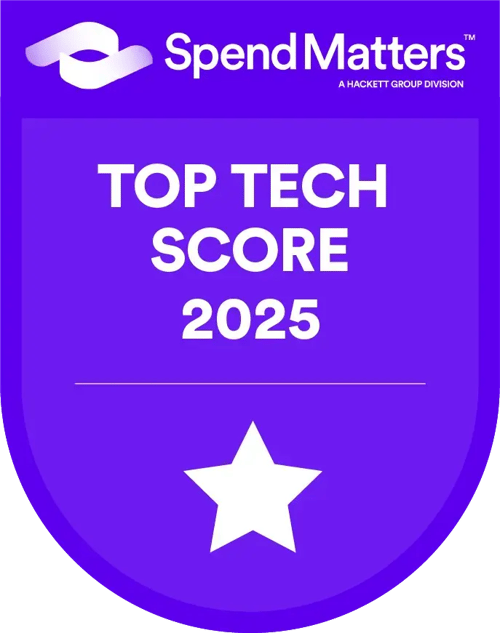KPIs (key performance indicators), also called metrics, are designed to measure the performance and effectiveness of procurement management.
Procurement KPIs can track all relevant aspects of purchasing or acquiring goods and services. We've all heard the saying "what gets measured, gets managed". They aim to highlight to what extent procurement strategy is contributing to business success or where it is falling short.
Well thought out KPIs identify savings opportunities, manage supplier risk, and streamline procurement activities across business units. Using a visual dashboard enables you to track and communicate KPIs in real-time and identify opportunities for improvement.
We have put together a complete list of procurement KPIs to pick and mix from. You can jump to specific KPIs by following the links below.
We hope you enjoy the list!
Cost savings KPIs
Most procurement professionals will agree that cost reduction is their #1 objective. In procurement, cost savings are the cumulated negotiated savings and discounts that are achieved based on an agreed baseline.

Price reductions/ hard savings
Cost savings are achieved through aggregating spend across business units or regions. As such, "hard savings" are the most basic KPI for procurement. They document the literal reduction of spend.
There are two basic ways to achieve hard savings on ongoing purchases: negotiating for a cheaper price with the current supplier or finding a different supplier with a better offer.
By using best practices in cost reduction, you can work towards real savings. Measure these KPIs to stay in tune with your hard savings:
👉 Cost development
👉 Cost Savings
👉 Purchase Price Variance (PPV)
👉 "Should cost" analysis
👉 Commodity benchmarking
👉 Commodity Price Fluctuation
Competitive sourcing/ contracts
Kearney’s 2020 study of 260 companies found 100% of procurement leaders interviewed said "Price reduction via sourcing and negotiations" had a high impact.
Of course, hard savings also come from choosing the right suppliers! Track these KPIs to see where you're saving in regard to sourcing and contracts:
👉 Contract savings/ discounts
👉 Payment term optimization
👉 Supplier price performance and benchmarking
Total Cost of Ownership
Total cost of ownership (TCO) is a methodology that considers all costs, direct and indirect, that are incurred during the entire procurement lifecycle.
It includes the original purchase price, plus any operating costs, process change costs, delivery costs, maintenance, and disposal costs. TCO looks at the bigger picture and considers the total value of the product or service over time.
This is a valuable KPI for procurement because it provides a total cost basis for the item or service. It also enables the comparison of different sourcing options as well as make-or-buy decision-making.
👉 Operational costs and delivery performance
👉 Productivity improvements
👉 Insourcing/ outsourcing initiatives
Cost avoidance/ soft savings
Cost avoidance is regarded as the “soft savings” that result for instance from avoiding a market price increase with negotiation.
Value is a pretty vague concept, but depending on your organization, it's good to put some real metrics to it. You can get creative with this!
👉 Procurement value creation
👉 Reducing value leakage
Spend under management KPIs

Many large organizations aim for up to 80% of spend under management. Where spend under management is high, procurement’s influence extends beyond savings to improving the visibility of spend and reducing supplier risk.
👉 % of total spend under management
The target may be set at an overall % or be based on % of spend under management per business unit/region/category of purchases only.
👉 % of spend under management (by unit)
Another way of viewing spend under management is through tail spend analysis: understanding what suppliers have the biggest impact.
👉 Tail spend classification and analysis
Supplier performance KPIs

Leveraging supplier performance is one of the key drivers for procurement. The aim is to limit risk, improve performance, manage quality, improve value to customers, minimize disruptions, and hold suppliers to account.
Supplier KPI examples include:
👉 Overall spend per supplier
👉 Order fill rate/supplier availability
👉 Average lead time, Lead time variance
👉 On-time delivery, Delivery accuracy, Defect rate
👉 Number of reclamations
👉 PO and invoice accuracy
👉 Compliance to contract
👉 Audits and corrective actions
👉 Communication lead time
Supplier risk KPIs
Following up number of sole source suppliers can indicate potential supply risk in case of disruptions. Tracking the number of suppliers on the database can show how many are active, in which categories, and where there is unnecessary overlap.
👉 # of single source suppliers
Traditionally, the aim has been to reduce the number of suppliers to reduce administration cost, but this is changing fast due to advancements in software solutions. Increasing the number of suppliers can reduce risk, promote diversity, and satisfy new market demands.
👉 Change in suppliers
Operational KPIs

Operational KPIs aim to establish what is happening in the day-to-day business to identify possible improvement areas.
The responsibility of proving the results and value of procurement is on CPOs. To showcase this, you can identify where processes, people, or systems are performing well and where not too well so that you can take corrective action and focus on what matters the most.
Procurement Return On Investment (ROI) showcases the ratio between the cost of procurement and savings or business value delivered.
👉 Procurement ROI
Cycle time is another measure of procurement efficiency. Cycle time tracks how long a certain task or activity takes to complete. The sooner you sign a contract or execute a project, the sooner you implement savings and satisfy your business stakeholders.
👉 Cycle time
👉 Time to award tender from sourcing request
👉 Time to negotiate a contract from tender award
Other operational KPIs include:
👉 # of (approved) suppliers
👉 # of invoices
👉 # of purchase orders (PO)
👉 Rate of emergency purchases
👉 Inventory value
👉 PO coverage
👉 PO cycle time
👉 Contract coverage
👉 Average payment term
👉 Payment term accuracy
Employee-related KPIs

Leading procurement organizations use KPIs to measure employee performance which also lays the basis for their reward programs.
These measures are not as robust as operational or cost-saving KPIs as they relate to human efforts and behaviors. To establish employee KPIs it is important to benchmark within the industry to set a baseline.
Employee-related KPIs include:
👉 Cost savings per employee
👉 Spend under management per employee
👉 # of suppliers managed per employee
👉 # of sourcing projects per employee
👉 # of contracts managed per employee
👉 # of new contracts negotiated per employee
👉 # of training hours completed per employee
👉 Customer satisfaction within the organization
Sustainability KPIs

Setting KPIs for sustainable procurement is a work in progress. Measuring responsible sourcing at suppliers is evolving. Areas of focus are social responsibility, labor practices, work safety, non-discrimination, modern slavery, anti-bribery, the environmental footprint of transport and logistics, utilities, and water conservation.
Sustainability KPIs include:
👉 Compliance with Code of Conduct
👉 Compliance with UN global conduct
👉 Compliance with environmental standards
👉 # of suppliers that filled in self-assessment questionnaire
👉 # of suppliers audited
👉 CO2 emissions reduction
👉 Waste reduction
👉 Plastic reduction
Sustainable sourcing will continue to develop and the KPIs must follow. We are starting to see evaluations of a supplier’s commitment to sustainable sourcing and its implementation of policy and processes.
Many suppliers are willing to show initiative in the hope of improved reputation and greater market share.
Diversity and local sourcing KPIs

Companies are adopting supplier diversity programs to make a positive impact where they operate, but also to harness the added revenue and innovation opportunities it brings.
Minorities, non-discrimination, and rights of the vulnerable groups were in the past taken into account as part of the corporate social responsibility (CSR) programs and reporting of companies. As the awareness is increasing, diversity programs have been differentiated into specific development areas to follow.
The next step is to evaluate diversity performance and make improvements to drive business growth and do good in the world.
Leading organizations are starting to track include:
👉 Minority-owned enterprises (MBEs)
👉 Woman-owned enterprises (WBEs)
👉 LGBTQIA+ -owned businesses
👉 BAME (Black, Asian, and Minority Ethnic) owned businesses
👉 Small- and medium-sized enterprises (SMEs)
👉 Above categories share of total spend
Conclusion
There is no definitive list or ranking of the most important Procurement KPIs. Some are more important than others in different industry sectors.
For example, measuring the number of undamaged shipments, delivery accuracy, and on-time deliveries is critical in retail e-commerce, but not so much in professional services.
For professional services measuring customer satisfaction and service level could be more relevant.
In addition, the maturity of the procurement organization impacts on most important KPIs to follow.
The trend toward managing a larger number of KPIs has driven procurement organizations to invest in software-as-a-service (SaaS) technologies, addressing spend analysis, P2P transactional tracking, supplier relationship management, and contract lifecycle management.
Picture by: Alexandr Bormotin



